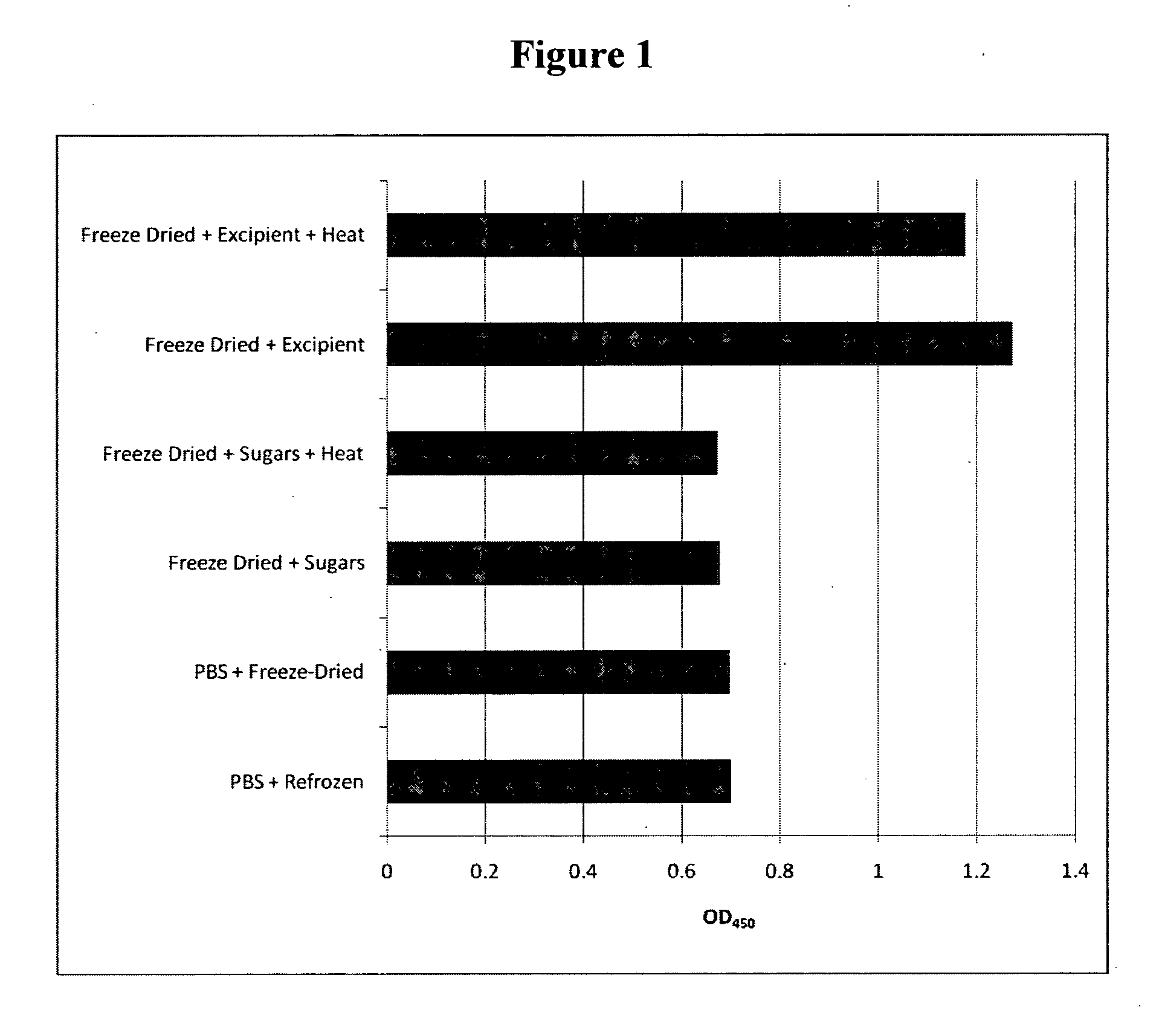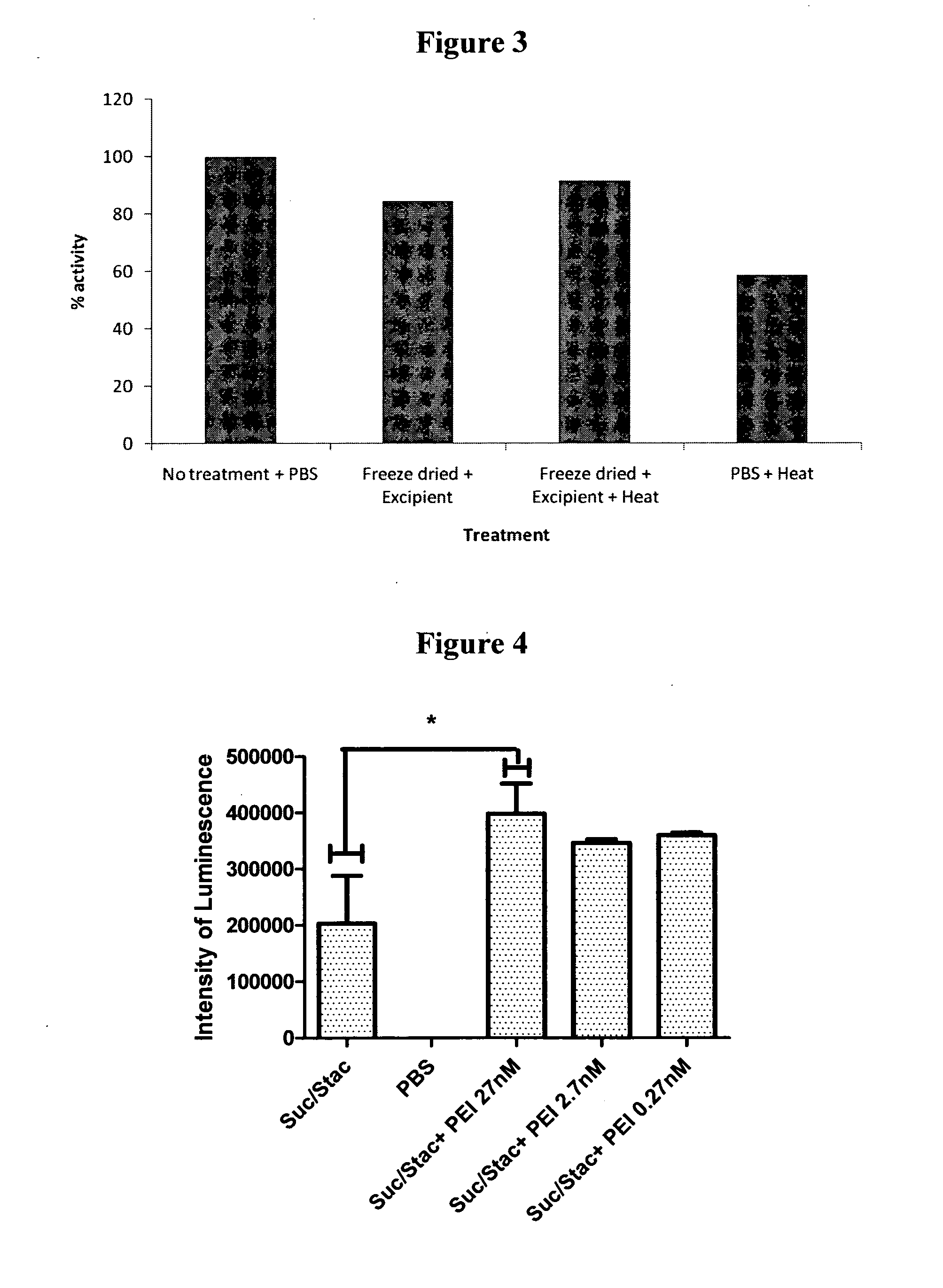Method for Preserving Polypeptides Using a Sugar and Polyethyleneimine
a polypeptide and polyethyleneimine technology, applied in the field of preserving polypeptides using sugar and polyethyleneimine, can solve the problems of unsatisfactory stability, added cost and inconvenience, and inability to use many materials, and achieve the effect of high sugar concentration and low concentration
- Summary
- Abstract
- Description
- Claims
- Application Information
AI Technical Summary
Benefits of technology
Problems solved by technology
Method used
Image
Examples
example 1
Stabilizing Calcitonin
[0250]Vials of desiccated hCT (human calcitonin) were obtained from Sigma (code T3535) and reconstituted in PBS (Sigma) to a final concentration of 3 μg / μl using the manufacturer's stated mass content before each experiment.
[0251]An aqueous solution of the sugars sucrose and raffinose (sugar mix) and PEI (Sigma catalogue number: P3143—solution 50% w / v in water; Mn 60,000) was prepared as 4 parts 1.82M sucrose solution: 1 part 0.75M raffinose: 1 part PEI (PEI concentration of 150 nM based on Mn). A 50 μl aliquot of the excipient was added to 3 μl hCT and the volume brought up to 60 μl with PBS. The final concentrations of the sugars and PEI were:
[0252]sucrose: 1.03M
[0253]raffinose: 0.09M
[0254]PEI: 21 nM (based on Mn of 60,000)
[0255]For controls, PBS was used in place of excipient. Multiple 60 μl aliquots were prepared for testing as follows:[0256]1. Calcitonin resuspended in PBS and frozen[0257]2. Calcitonin resuspended in PBS and freeze-dri...
example 2
Preservation of Human Recombinant G-CSF
1. Materials and Methods
Materials
[0269]An antibody for phospho-specific ERK1 / 2 was purchased from Sigma (Dorset, UK) and anti-ERK 2 was obtained from (Zymed UK). PEI (Mn60,000; Sigma catalogue number: P3143), sucrose (Sigma), raffinose (Fluka), PBS (Sigma), glass vials (Adelphi glass), rubber stoppers (Adelphi glass) and G-CSF (Sigma).
[0270]A lyophilised sample of G-CSF was reconstituted to a concentration of 10 μg / ml. 160 μl of sucrose (1.82M) and 40 μl of raffinose (0.75M) were mixed with 50 μl of PEI (at a concentration of 150 nM based on Mn) to complete the preservation mixture. 50 μl of the reconstituted G-CSF solution was added and mixed well. The final concentrations of the sugars and PEI were:
[0271]sucrose: 0.91M
[0272]raffinose: 0.125M
[0273]PEI: 25 nM (based on Mn)
[0274]100 μl aliquots of the final mixture was distributed into separate vials, and frozen or freeze-dried. Lyophilisation was carried out overnight as descr...
example 3
Stabilisation of Anti-TNFα Antibody
1. Experimental Outline
[0289]The following samples of anti-human tumor necrosis factor-α antibodies (rat monoclonal anti-TNFα, Invitrogen Catalogue No.: SKU#RHTNFA00) were prepared and their preservation assessed by the retention of their normal functional activity of binding hTNFα using an ELISA assay after the indicated treatment:[0290]1. anti-hTNFα rat mAb (test)—no treatment+PBS (4° C.) (control)[0291]2. anti-hTNFα rat mAb—freeze dried+excipient and stored at 4° C.[0292]3. anti-hTNFα rat mAb—freeze dried+excipient and heat treated at 65° C. for 24 hours[0293]4. anti-hTNFα rat mAb—heat treated+PBS at 65° C. for 24 hours
[0294]The excipient contained a final concentration of 0.91M sucrose, 0.125M raffinose and 25 nM PEI (Mn 60,000). An ELISA plate (NUNC ELISA plate (MaxiSorp™)) was coated with the rat monoclonal antibody (rat hTNFα mAb) directed against hTNFα. hTNFα was added to the plate and allowed to bind to the coated plate. Bound hTNFα was de...
PUM
| Property | Measurement | Unit |
|---|---|---|
| Mn | aaaaa | aaaaa |
| Mn | aaaaa | aaaaa |
| Mn | aaaaa | aaaaa |
Abstract
Description
Claims
Application Information
 Login to View More
Login to View More - R&D
- Intellectual Property
- Life Sciences
- Materials
- Tech Scout
- Unparalleled Data Quality
- Higher Quality Content
- 60% Fewer Hallucinations
Browse by: Latest US Patents, China's latest patents, Technical Efficacy Thesaurus, Application Domain, Technology Topic, Popular Technical Reports.
© 2025 PatSnap. All rights reserved.Legal|Privacy policy|Modern Slavery Act Transparency Statement|Sitemap|About US| Contact US: help@patsnap.com



